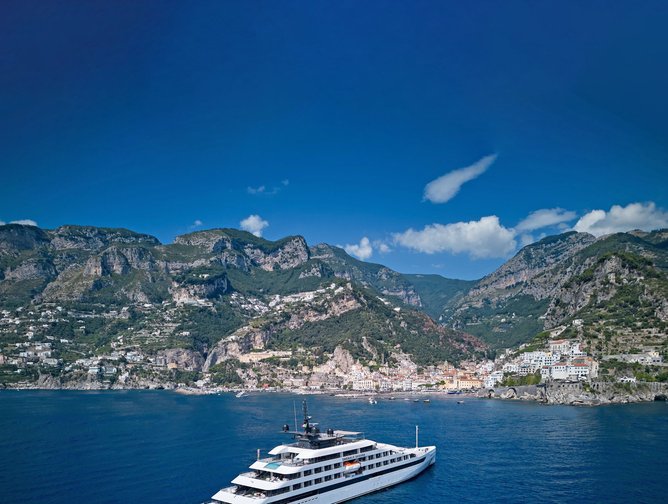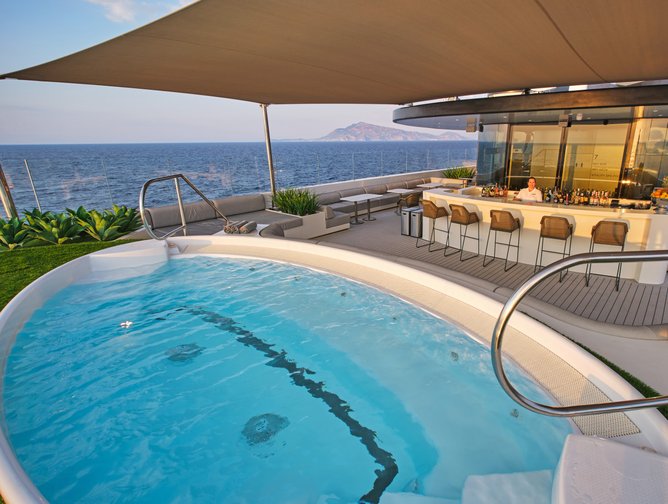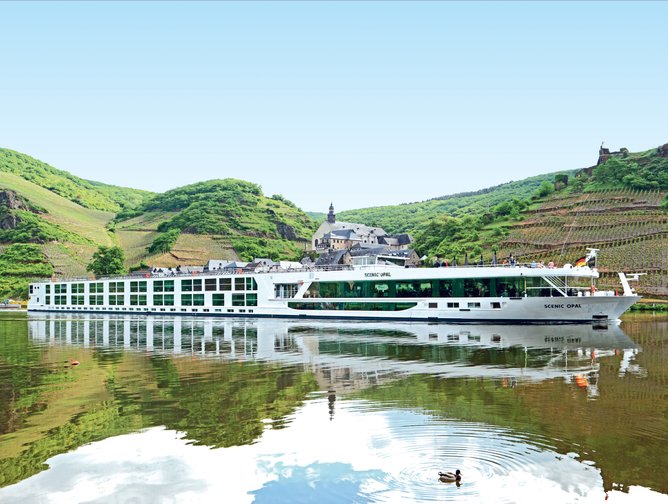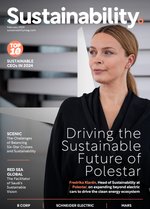Most people are familiar with the phrase ‘leave nothing behind but footprints’ when it comes to responsible travel and tourism, but that simply doesn’t cut it in 2024.
While making minimal impact and moving on is laudable, how about making a positive impact as you encounter communities instead?
That ethos is being adopted by Scenic Luxury Cruises & Tours which works closely with and funds local projects that help to maintain the natural beauty and improve living conditions in the regions it visits.
From providing clean drinking water in Vietnam to supporting a school in Kenya, Scenic's Cherish the Planet pledge goes beyond sustainability – it's a commitment to creating positive change.
Driving that change first in Asia and then on a global level is Phil Jordan, Director of Sustainability & Delivery at Scenic, who has seen the company evolve and expand in his 10-year tenure.
“Ten years ago, when I started with the company, we were very much river cruise specialists,” says Jordan.
Today, the Australia-born company has more than 26 vessels across Scenic’s river cruise ships, Scenic Eclipse Discovery Yachts and Scenic’s sister brand, Emerald Cruises. The company operates across the seven continents and has employees working globally.
“I started as a Product Delivery Manager looking after everything outside of Europe and Canada. There was an expansion within Europe & Asia River Cruising in my time, but where the company really evolved was in the ultra-luxury yacht cruising market.”
The luxurious Emerald Yachts operate in the Caribbean and Mediterranean, taking up to 100 guests. Launched in 2019 and 2023 and with only up to 228 guests (or 200 in Antarctica), Scenic Eclipse I and II set the benchmark in truly all-inclusive ultra-luxury cruising. Travelling in Cruise, Discovery or Expedition mode, guests can visit from the Arctic to Antarctica; the Mediterranean and Northern Europe to Asia, Oceania, South Pacific and the Americas.
These are truly once-in-a-lifetime journeys. Imagine visiting Antarctica aboard Scenic Eclipse and following in the footsteps of famous explorers in the last great wilderness frontier. Wildlife encounters with penguins and whales are led by the Discovery Team of up to 20 experts – from historians to geologists and glaciologists. Guests can enjoy unrivalled discovery on Zodiac, kayak and stand-up paddleboard excursions, taking further to the skies in one of two on-board helicopters or exploring below the ocean on Scenic’s custom-built submersible, Scenic Neptune.
Of course, all of this luxury comes with sustainability credentials.
“Our Cherish the Planet manifesto outlines everything we’re doing and is based on UN Sustainable Development Goals,” explains Jordan.
“We focus on six pillars – reducing our waste, addressing our CO2 emissions, sourcing sustainably, growing with communities, valuing diversity, and advocating health, safety, and security.”
“Our Airbus H130-T2 aircraft are the quietest in the skies, ensuring minimal disturbance to wildlife. As a proud member of IAATO (International Association of Antarctica Tour Operators) and AECO (Association of Arctic Expedition Cruise Operators), Scenic is committed to responsible and sustainable tourism in the Antarctic and Arctic regions. This means we adhere to strict guidelines, prioritise environmental protection, respect local cultures, and ensure safety while actively contributing to scientific research and awareness.”
From all but eliminating single-use guest plastics, to measuring and mitigating emissions, and sourcing local produce to support communities, Scenic sets out to be as good as it can be.
“There's no such thing as a perfect product,” admits Jordan. “To be completely transparent, we are a provider of luxury holidays and tours and first and foremost, that is what we will always be.
“We are committed to developing sustainable experiences which benefit both guests and the community and align with our ESG goals.”
Jordan points to the cultural interaction and learning, the positive social impacts of tourism, and engagement and consultation with community leaders and representatives as some of the achievements of Scenic’s sustainability programme. It is important to see how those communities can benefit – not just in the touristic season but also in the future.
“We believe that if we can create great, meaningful inclusions that the guests love, but also follow our ESG goals, then it's a win-win for everyone,” says Jordan. “It’s better for the communities, better for our guests, and better for the planet.”
Tackling plastics
For a company that literally owes its livelihood to water, Scenic makes clean drinking water and eliminating water waste a top priority.
While many countries in the developed world take clean drinking water for granted, and have a bewildering array of bottled water available when tap water is perfectly safe, many people in developing countries still struggle to find a clean, accessible supply.
Onboard the Scenic ships, there was also the challenge of removing all single-use guest plastics, which added an extra dimension to the drinking water challenge.
“The amount of single-use plastics that are used is mind-blowing and water bottles especially,” says Jordan. “ So water bottles were one of the very first things we tackled. But this is something that needs to be thought about very carefully – and I think that can be applied to a lot of things in the realm of sustainability. There's no point in a place like Vietnam, or elsewhere in Southeast Asia, giving everyone a plastic refillable bottle when you're not providing the means to refill it.”
Jordan says education is key – not just for the local communities who are being asked to change their habits, but also Scenic guests and staff.
Scenic’s approach was to provide guests with stainless steel refillable bottles and to provide refill options on all vessels and vehicles, but even that proved challenging.
One of the big problems Jordan encountered was guest perception – and convincing them that bottled water was the safest option.
“That was a big hurdle to overcome,” he admits. “We have very advanced systems on our ships for the water refill stations – including reverse osmosis, ultraviolet and carbon filtration that are regularly tested at international institutes to confirm its quality.
“But we needed guests to understand that, and we needed them to know that the safest option for them and the best option for the environment was what we were providing.”
Jordan also highlights the black market for water in Southeast Asia, with ‘fakes’ readily available, resealed bottles, and relabelling. That means bottled water may not be what it seems. The water served on the ships, however, can be controlled.
Guests are also encouraged to bring their own refillable bottles, or to empty their cupboards of unused bottles and donate them to Scenic’s ‘second life’ programme, where they partner with the VinaCapital Foundation that instals clean water filtration units in schools.
By providing clean water and education in schools on the need for sustainable solutions, Jordan says hopefully that message gets passed along to parents and grandparents, with less single-use plastics heading to landfill.
Sustainable sourcing
On a ship like Scenic Eclipse, which may have 200 guests in Antarctica being served in 10 restaurants, you could be forgiven for thinking that food waste from lavish buffets must be a problem.
Not only that, but how do you reduce those food miles and also ensure you are sourcing fresh produce from local suppliers where possible?
Jordan explains that while people may think food waste is “off the charts”, it is actually the opposite. “In most of our restaurants, nearly everything is made to order, prepared from kitchen to plate,” he says.
“This is great for reducing food waste and it allows our chefs to be smarter about how they are procuring. So when they are looking at ingredients and dishes for these multiple venues, they are not simply buying and cooking in bulk, they are using what is required and menu planning to maximise use and minimise waste.”
Technology also helps, with sous vide machines, for instance, reducing the use of oil and saving energy as opposed to high-temperature cooking.
Very little goes to waste, and things that are left over that can be put into the dehydrator are. That could be a slice of lemon for a cocktail or for creating mushroom dust for a dish. Micro-herbs are also grown onboard and picked as plates are prepared.
“For those ocean ships, we zoom the lens out a bit wider,” says Jordan. “We've also created our own sustainable sourcing guidelines – quite a lengthy document of over 50 pages which we use both internally and externally with our suppliers. This outlines what our expectations are, what we want to achieve, why we are doing it this way.
Scenic also gives suppliers the option of a self-assessment form so they can talk about what they are doing internally as a company, and it allows Scenic to focus on how they can work together, what advice they can give suppliers, and what they can learn from them.
“It's not a set of strict rules that everyone has to abide by, we're just being very open and honest and sharing what we want to achieve and what we're trying to do,” says Jordan.
This approach to sustainable food sourcing and commitment to local produce extends to shore excursions and guest experiences, where passengers visit the growers and farmers.
“Guests can actually see the produce being picked that might be in the meal that they have that night,” says Jordan. “Food always tastes better when it can tell a story. So if you're dining on a ship, and you have some kind of connection to the ingredients on that plate, it makes for a better, rounded experience. And so that’s what we're trying to provide to the guests – helping to create those moments.”
Scenic is always looking for ways to make its operations more sustainable, while ensuring a great guest experience.
Jordan says he thinks the cruise industry is very similar to the aviation industry in that a lot of the emissions almost entirely depend on the fuel sources, but until there is a commercially and financially viable alternative available – like sustainable aviation fuel – it is very hard to change that.
“We've got a long way to go, both as a company and as an industry, no doubt about it,” says Jordan. “The main, overarching goal is always to be better in this space than we were yesterday. And if we are better tomorrow than we were today, we can keep moving in the right direction.”
Jordan believes that understanding and education, not just across sustainability and ESG, but a range of topics in society, presents both the biggest challenge and the biggest opportunity.
“I think a lot of people expect that they know what sustainability is, but the reality is it's all-encompassing and very complicated and fluid, and it evolves,” he says.
“One of the biggest challenges is that fundamental misunderstanding or misconception of sustainability, but I think that represents an opportunity.
“It doesn't mean a company is going to be less profitable, in fact, probably the opposite. It doesn't mean that it’s going to be less enjoyable if it's sustainable. When you start to have the masses all pulling in the same direction for a common goal and understanding why, that's when you start seeing real progress.”
Make sure you check out the latest edition of Sustainability Magazine and also sign up to our global conference series - Sustainability LIVE 2024
**************
Sustainability Magazine is a BizClik brand






